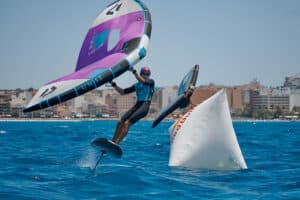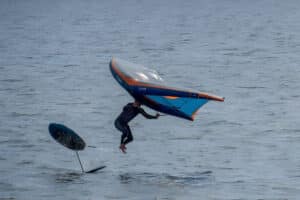Wing foiling can be challenging to learn, but it’s not insurmountable for most people with determination and the right approach. While it does present a steep learning curve, particularly in balancing on the foil board and handling the wing simultaneously, many enthusiasts find it easier to pick up than other water sports like kiteboarding or windsurfing.
The difficulty level largely depends on factors such as your prior water sports experience, physical fitness, and the conditions in which you’re learning. Beginners often struggle with mastering multiple skills at once, but with proper instruction and practice, most can grasp the basics within a few sessions.
This article will explore the challenges faced by beginners, offer tips to make the learning process easier, and provide insight into how long it typically takes to become proficient in wing foiling.
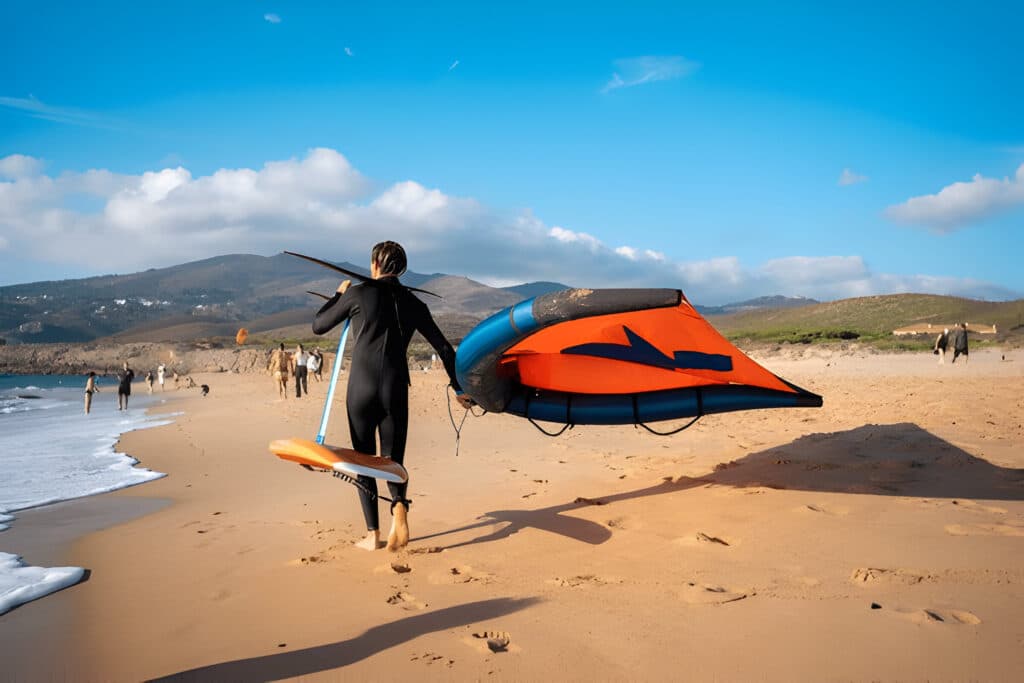
Challenges for Beginners
Balancing on the Foil Board
Unlike traditional surfboards or paddleboards, foil boards have a unique design that requires a different approach to stability. The foil, attached underneath the board, creates lift as it moves through the water, elevating the board above the surface. This dynamic creates a new dimension of balance that beginners must learn to manage.
The challenge lies in maintaining equilibrium while the board is both on the water and in flight. When learning, many beginners struggle with the transition from water-start to foiling, often experiencing sudden lifts and drops as they attempt to control the foil. According to a study by the International Journal of Aquatic Research and Education, it takes an average of 10-15 hours of practice for most beginners to achieve consistent balance on a foil board in calm conditions.
Handling the Wing
Another significant hurdle for wing foiling enthusiasts is mastering the control of the wing itself. The hand-held wing, typically ranging from 4-5㎡ to 6m2 in size, acts as both a sail and a balancing tool. Beginners often find it challenging to coordinate the wing’s movements with their body position and the board’s direction.
The wing requires constant adjustment to harness the wind effectively. Beginners must learn to sheet in (pull the wing closer) to generate power and sheet out (push the wing away) to reduce power.
Steep Learning Curve at First with Many Skills to Master Simultaneously
Wing foiling presents a unique challenge as it requires the simultaneous mastery of multiple skills. Beginners must learn to:
- Balance on the foil board
- Control the wing
- Read wind and water conditions
- Understand foil dynamics
- Maintain proper body positioning
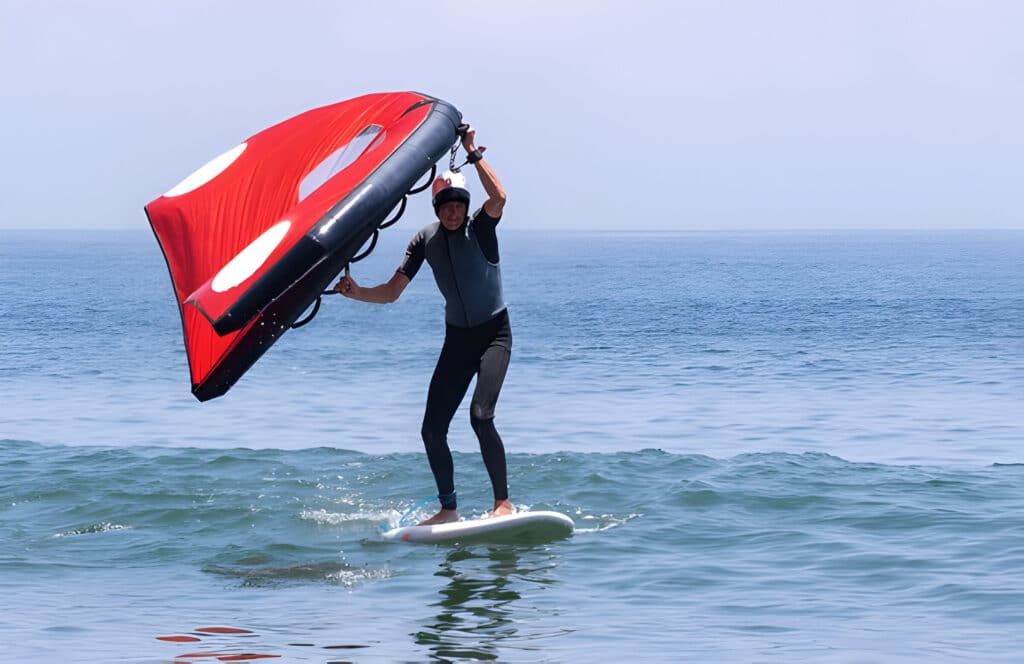
Tips to Make Learning Easier
To make learning wing foiling easier, consider the following tips:
- Choose beginner-friendly gear: Start with a large-volume beginner windsurf board or a non-foiling board with a leash. Select a 4-5㎡ or 6m2 inflatable wing, depending on your weight and wind conditions.
- Take professional lessons: Enroll in lessons from a certified instructor or reputable kite shop to learn proper technique and safety protocols, accelerating your learning curve and avoiding bad habits.
- Select suitable learning conditions: Begin in calm, flat waters with steady winds of 15+ knots (approximately 17-18 mph). Shallow water is preferable for easy resetting.
- Master fundamentals before foiling: Practice wing handling on land and in water without the foil attached. Focus on maintaining balance and controlling the wing in various conditions.
- Leverage prior foiling experience: Experience with other foiling disciplines, such as kite foiling or wake foiling, can accelerate your learning in wing foiling.
- Progress gradually: As your skills improve, experiment with stronger wind conditions and larger wings, always prioritizing safety.
- Focus on body weight distribution: Practice shifting your weight between your front and back foot to manage pitch control and achieve a stable riding position.
How Long Does It Take to Learn
For most beginners, mastering the basics of wing foiling typically requires 10-20 hours of practice spread over several sessions.
Those with previous experience in water sports, particularly wind-based activities like kitesurfing or windsurfing, may progress more quickly.
The learning process typically follows this progression:
- Mastering wing handling on land (2-3 hours)
- Balancing on the board and basic steering (3-5 hours)
- Getting up on the foil for short bursts (5-10 hours)
- Maintaining foiling for extended periods (10-20 hours)
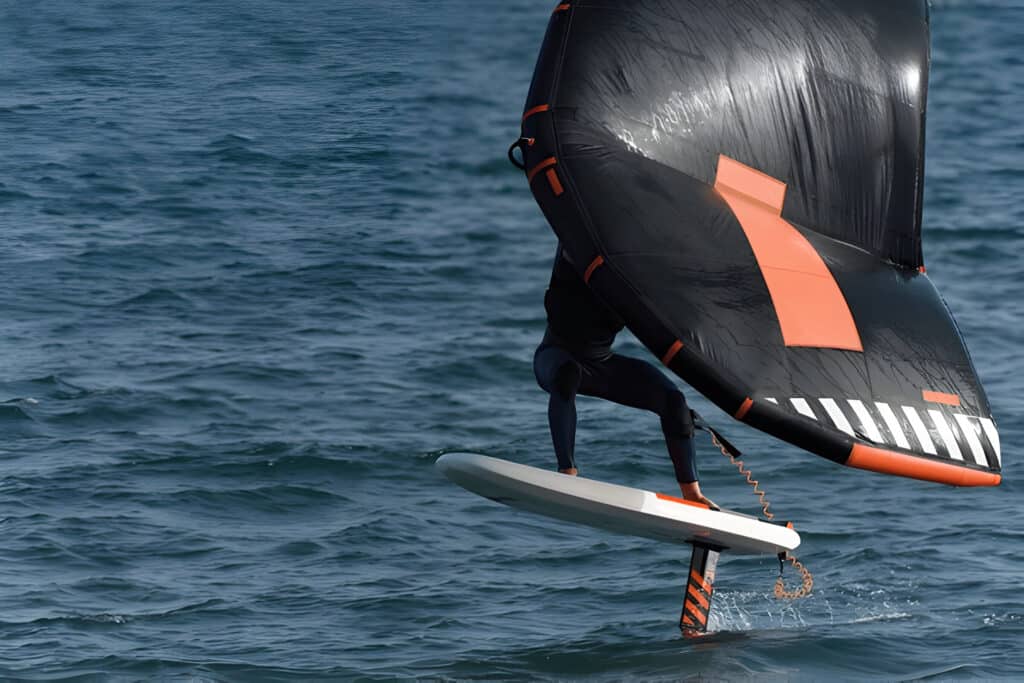
How Wing Foiling Compares to Kiteboarding, Windsurfing, Surfing and Foiling (Kite/Surf)
To provide a comprehensive comparison of wing foiling to other water sports, we’ve created a detailed table that highlights key aspects of each discipline. This comparison will help wing foiling enthusiasts and beginners understand the unique characteristics of each sport.
| Aspect | Wing Foiling | Kiteboarding | Windsurfing | Surfing | Foiling (Kite/Surf) |
|---|---|---|---|---|---|
| Learning Curve | Moderate to Steep | Steep | Moderate | Moderate | Steep |
| Wind Requirements | 10-15mph winds | 12-25mph | 10-25mph | No wind needed | Varies (10-20mph for kite, no wind for surf) |
| Equipment Complexity | Moderate (wing, board, foil) | High (kite, bar, board) | High (sail, mast, boom, board) | Low (board only) | High (foil, board, kite/paddle) |
| Portability | High (inflatable wing, compact board) | Moderate | Low (large sail and board) | High | Moderate |
| Skill Transfer from Other Sports | High (kiteboarding, windsurfing, foiling) | Moderate | Moderate | Low | High (from respective base sport) |
| Versatility in Conditions | High (flat water to waves) | High | Moderate | Limited to waves | High |
| Physical Demand | Moderate | High | High | High | Moderate to High |
| Safety Considerations | Moderate (foil-related risks) | High (kite power, long lines) | Moderate | Low to Moderate | High (foil-related risks) |
Conclusion
Wing foiling, while challenging, offers an exhilarating water sport experience that combines elements of windsurfing, kiteboarding, and foiling. As we’ve explored, the difficulty of wing foiling stems from mastering the waterstart, coordinating multiple elements simultaneously, and adapting to varying wind and water conditions. However, factors such as prior experience in related sports, fitness level, ideal learning conditions, and appropriate gear choices can significantly impact the learning curve.
For those eager to embrace this exciting sport, following the provided tips can make the learning process smoother and more enjoyable. While wing foiling may present unique challenges compared to other water sports, it also offers distinct advantages and a thrilling new way to harness the power of wind and water.
